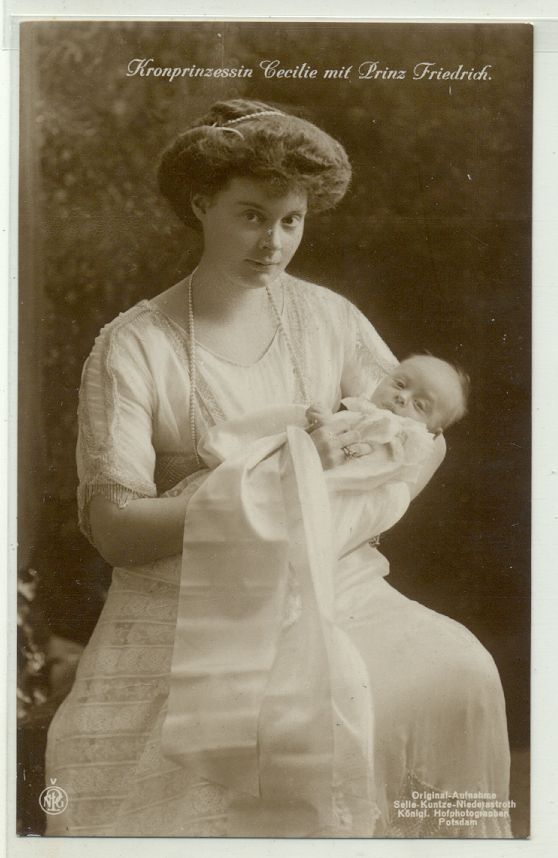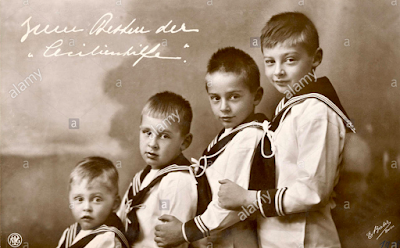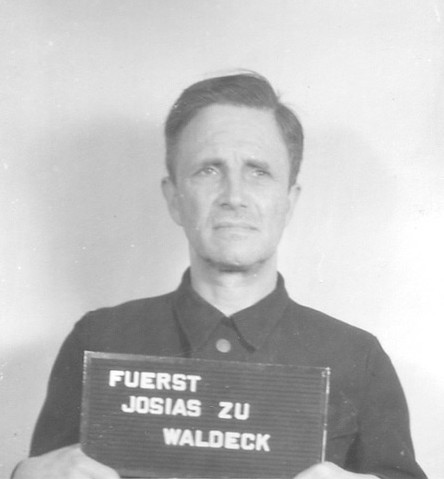In 1936, Friedrich attended the funeral of King George V, which took place on 28 January. The prince's future brother-in-law, Sir Henry "Chips" Channon, the husband of Lady Honor Guinness, remarked in his diaries: "Fritzi of Prussia looked very handsome in a white uniform, and the King of Rumania [Carol II] look ridiculous as ever." Later that same year, the Channons paid a visit to Germany from August until September. During their stay, Chips and Honor were invited by Friedrich to visit his mother the Crown Princess. Chips recalled this episode in his diary entry of 10 August 1936:
Yesterday Fritzy rang up to say that his mother, the Crown Princess, expected us to luncheon today, and we wondered what to wear for this royal engagement.
I thought that grey flannels would be appropriate for lunch in the country anywhere, but, on the whole, we decided black might be more correct and so black it was, with Harold Balfour and I in our House of Commons uniforms, and Honor beautifully dressed in semi-grand 'dayers.' Cecilienhof, which the Imperial Family thinks looks very English, is a dreadful Lutyens sort of house, ugly and bogus Tudor, built just before the war. That it overlooks a lake is its only consolation. Fritzy met us and led us to the water's edge, where we found Princess Cécile, his second sister, an intelligent, half cross-eyed girl of eighteen, bathing with young Lord Jellicoe. The house itself is very royal with plush, palms, bareness, and faded, signed photographs of dead monarchs. Fritzy showed us his mother's bath-cum-dressing room, which she has fitted up as a yacht, to remind her of Kiel, and we were laughing a little, when the door opened and the Crown Princess walked in, large, smiling, and gracious. 'Thank you so much for all your kindness to my child,' she said to the curtseying Honor. She looked very, very royal, with gold, jingling bracelets, large single pearl earrings, simple clothes and a Fabergé brooch. We filed in to luncheon in a large dining room and Honor was between the two princes, I on the right of the Crown Princess. She is indeed very much a Mecklenburg, that is, dark and rather Russian (she is a double first cousin of my adored Princess Nicholas, whose mother, the Grand Duchess Vladimir, was a Mecklenburg). All the Mecklenburgs have a frivolous outlook and are dark, charming and well-bred. Princess Marina, for instance. They all have a habit of talking in a slightly guttural voice, and their catch phrases are 'poor thing,' 'do you find,' and 'it makes me the impression.'
 |
| The Duke and Duchess of Sutherland |
In May 1937, Prince Friedrich attended a ball hosted by the George and Eileen, Duke and Duchess of Sutherland. Again, we turn to Chips Channon, who, as ever, was present and ready to document his impressions of the evening. On 18 May, Chips took to his diary:
The Sutherlands' Ball. A dazzling night. Honor looked magnificent with all her sapphires, tiara and a resplendent blue brocade number made to match the Amalienburg and we were hardly dressed and down before the brace of young princelings, Ernst August of Hanover, and Fritzy of Prussia, very young, fair and Nordic and dripping with decorations, arrived almost too punctually. Soon after nine we swept into dinner, and the dining room was a gorgeous, glittering sight of jewels shimmering in the candle-light, of Meissen china, of decorations and splendour. Mrs Grenville was delighted to be next to the young Prince of Prussia and there was great stimmung and excitement. At 10.45 Honor and I with Ernst August, jumped into our car, and armed with a special white card we drove to the Royal entrance - rather to everyone's annoyance, at Hampden House. The Ball was the best spectacle so far of the summer; we were ushered into an improved ballroom hung with tapestries, with, at one end, an enormous dais of red baize where all the Royalties of the earth seemed congregated. We had barely arrived when the King and Queen entered with the Sutherlands. All four were gay, smiling and impressive, and I noticed how both the King and Queen have gained greatly in presence and dignity. They went up to the queue of Royalties and greeted them all, kissing many. The Queen was in white, with an ugly spiked tiara, and she showed no sign of her supposed pregnancy, which I am beginning to doubt. The King followed her, showing his teeth. Queen Mary was in icy blue; soon the ball began. Honor and I were dancing near the dais when we caught Queen Mary's eye, and we stopped to curtsey and bow as she held out her hand. Then Honor and I became separated and I danced with Lady Iveagh. Later I danced with Alice Hofmannsthal, and we went up to the dais to talk to Princess Olga who was wearing her mother's ruby parure. We chatted with her for a few minutes, and as we turned we saw the King and Queen coming up to us, and they very smilingly talked to us. Both Alice and I were thrilled, which was unreasonable as we have both known them for years, and at one time intimately.
 |
| Friedrich's father German Crown Prince Wilhelm with Adolf Hitler |
Two years passed before Chips Channon mentions Friedrich of Prussia again in his diary. On this occasion, the United Kingdom was bracing for the possibility of armed conflict with the Third Reich. Chips confided the contents of this meeting with his friend, which took place on 15 April 1939 at Kelvedon:
Fritzi of Prussia, who is staying here told me today that Hitler dined quietly some years ago at Cecilienhof with his parents, and that he had sat on a sofa after dinner, and had solemnly declared that it was his intention of restoring the German Monarchy directly he could. They believed him, and indeed perhaps he meant it, at the time. Perhaps he meant it altogether. Fritzi also told me that he had no intention of fighting for the Nazis, whose régime he thinks not only repugnant but doomed.
 |
| Friedrich of Prussia |
Prince Friedrich was true to his word that he would not take up arms for the Nazis, in the way that his eldest brother Prince Wilhelm ended up doing and, as a result, being killed in action in May 1940. Instead, Friedrich was studying at Cambridge, living incognito as the Count von Lingen, when war broke out in September 1939. The prince was arrested and interned in May 1940. Friedrich was held in England for several months, then sent to internment camps near Quebec City and soon afterwards, Farnham, Quebec. In both camps, he was elected camp leader by fellow inmates.
In December 1944, Prince Friedrich became engaged to Lady Brigid Guinness (1920-1995), the daughter of Rupert Guinness, 2nd Earl of Iveagh, and his wife Lady Gwendolen Onslow. He shared this news with his old friend and soon-to-be brother-in-law, Chips. Naturally, Channon went on to document the exchange in his diary:
Fritzi of Prussia came to see me, and told me of his engagement to my sister-in-law Brigid [Guinness]: I am entranced, and was so moved that in a sad flash I remembered the days when we were all so happy, and did not know it.
 |
| Prince Friedrich of Prussia and Lady Brigid Guinness after their wedding |
On 30 July 1945 at Little Hadham, East Hertfordshire, Prince Friedrich of Prussia married Lady Brigid Katharine Rachel Guinness. Described as "tall and flaxen-haired," the groom was thirty-three, and the bride turned twenty-five on her wedding day. The couple were united in a very simple ceremony: they had known one another since the late 1930s.
Prince Friedrich and Princess Brigid went on to have five children: Prince Nicholas (b.1946), Prince Andreas (b.1947), Princess Victoria Marina (b.1952), and then the twins Prince Rupert and Princess Antonia (b.1955). In October 1947, Friedrich renounced his German citizenship and acquired British nationality under the Sophia Naturalisation Act of 1705: he henceforth was legally Friedrich von Preussen.
 |
| Brigid and Friedrich of Prussia |
Over time, the marriage of Friedrich and Brigid deteriorated. By the mid-1960s, their marital union existed in name only. Brigid was living with Major Anthony Patrick Ness, whom she would eventually marry.
 |
| Prince Friedrich of Prussia |
On Tuesday, 19 April 1966, Prince Friedrich went missing in Germany. He had been staying at his residence at Reinhartshausen Castle in Erbach. The first reports of the missing prince hit the international press on Saturday, 23 April. It was at this stage that Interpol had been asked to aid in his search. A Canadian paper wrote: "Hermann Mumm, chief commissioner of the Wiesbaden state police, said today an alert was circulated throughout West Germany after a local search failed to turn up any trace of the 54-year-old prince. The prince is believed the have taken an after-dinner stroll along the Rhine River near his Erbach hotel. When he failed to show up Wednesday morning, hotel employees called police."
 |
| The wedding of Duke Carl Gregor and Princess Maria Margarethe of Hohenzollern takes place as planned |
The next day, an update was released. In order to find the prince, "helicopters, bloodhounds and scores of police today searched the Rhine Valley...the mystery of his disappearance shadowed one of Germany's rare royal weddings. Duke Carl Gregor of Mecklenburg, 32, and Princess Maria Margarete Von Hohenzollern, 37, were married [yesterday] at Hechingen as scheduled." Louis Ferdinand, Friedrich's older brother, had been scheduled to attend their cousin Maria Margarethe's wedding along with his wife Kira; however, in view of the situation, Louis Ferdinand did not go and worked to head up the search efforts.
 |
| Article from the Philadelphia Inquirer that appeared on 27 April 1966 |
As days passed, the police had to abandon their search of the Rhine Valley. The case was turned over to detectives. It emerged that Friedrich was aware that he was going to be the subject of a divorce action brought by Brigid, which was supposed to take place in May - this was confirmed by Princess Kira. The same day that this news emerged, Prince Louis Ferdinand issued an optimistic statement about his younger brother, saying, "My feelings tell me he is still alive." In light of events, Princess Brigid and her eighteen-year-old son Prince Andreas traveled from England to Erbach - it was noted that Brigid refused to speak to the press. Although they had found several pages from Friedrich's chequebook along a path near the Rhine, and had dragged the Rhine River itself to find a body, police stated that they had no reason to believe that the prince's disappearance was due to a crime or suicide. The police stated "that investigators will now restrict themselves to following up any tips they receive."
 |
| Princess Antoinette of Croÿ, the last person to speak to Friedrich, seemingly disappears |
 |
| Princess Antoinette of Croÿ (1915-2011) |
On Saturday, 30 April, eleven days after he went missing, it was reported that Prince Friedrich of Prussia had visited Frankfurt's police headquarters to register as a resident earlier on the very day that he later disappeared. Further, it came to light that Princess Antoinette of Croÿ (1915-2011), who was the last person to speak to Friedrich on the phone on 19 April, had also apparently vanished; although, it must be said, that the princess' housekeeper stated that "
she [Antoinette] simply went on vacation," which was likely the case, as the princess later returned from wherever she went. Before she left, Antoinette had told the Hohenzollern family that Friedrich had mentioned nothing to indicate what was to come during their telephone call, and that the pair had agreed to meet during the weekend - at which time the prince did not show up. The papers also learned that the divorce action between Friedrich and Brigid of Prussia was supposed to be heard by a Frankfurt court on Tuesday, 3 May; however, given the circumstances, it was confirmed that the case would be delayed if the prince was not found before then.
Finally, on Monday, 2 May 1966, the case of the missing Prussian prince was solved. Friedrich's body had been found on Sunday, 1 May, in the Rhine River. In the Calgary Herald, a report was filed by the Associated Press from Bingen, West Germany:
Police announced Sunday they have found the body of Prince Friedrich of Prussia, grandson of Germany's last kaiser, who had been missing since April 19.
They said the body was recovered from the Rhine River near this town 18 miles downstream from the Reinhartshausen Schloss Hotel where he vanished on a midnight walk. The prince owned the hotel, a converted castle only 50 yards from the edge of the river at Erbach.
SUICIDE POSSIBLE
Chief Prosecutor Hans Klein, in charge of the investigation, said the situation "appears to indicate suicide but there is no definite evidence. The official cause of death has yet to be determined."
The 54-year-old prince, who had lived in England for most of the last 30 years, is survived by his wife Lady Brigid Guinness, and five children.
Last week, the chief investigator in the search for the prince said it had been confirmed that divorce proceedings to end the prince's 20-year marriage to the Guinness brewery heiress were pending in Frankfurt. The first hearing was to have been held Tuesday in a West German court.
KNEW ABOUT WORRY
Prince Louis Ferdinand, oldest brother of the dead prince and chief of the house of Hohenzollern, was informed of the death. He said in a statement last week he knew his brother "was deeply concerned about something about which I and various family members of the family will give no information. It concerns a circumstance from which suicide appears to be excluded."
Discovery of the body came after police search had been broken off. For more than a week, scores of police, supported by helicopters, had combed the woods surrounding the hotel.
FOUND BY PILOTS
Three pilots operating boats between here and Lorelei Rock discovered the body, which was fully dressed. Gold cuff links, bearing the crown of Prussia with the prince's initials, provided the first hint as to the identity.
Friedrich George Wilhelm Christoph, prince of Prussia, was the son of Crown Prince Friedrich Wilhelm and a great-great grandson of Queen Victoria.

In the late evening on the day when her husband's body was found, a statement was issued by Brigid of Prussia from London which read, quite simply: "The divorce proceedings that were pending between the late Prince Friedrich of Prussia and his wife were on the grounds of incompatibility alone." Articles from that same day reported that Friedrich had resumed usage of his princely title [which he had initially discontinued upon becoming a British subject] in 1951 and reacquired German nationality in 1953. A source close to the Prussian royal family stated that "Friedrich had been in an state of utter despair" over the imminent breakup of his marriage; family friends were also quoted as saying that the prince "had pushed off divorce for years for the sake of the children." Prince Louis Ferdinand confirmed that his younger brother had been suffering from acute depression.

A Luthern memorial service for Prince Friedrich of Prussia was held on Wednesday, 4 May, at the chapel in Erbach. It was attended by his widow, Brigid, and by other members of the Prussian royal family. The prince was buried at Hohenzollern Castle.
 |
| Anthony Patrick Ness in his youth |
On 6 June 1967 at Old Windsor, Princess Brigid of Prussia (née Guinness) took as her second husband Major Anthony Patrick Ness (1914-1993). A widower, Anthony Ness had wed in July 1946 Patricia Hyacinth Lydekker (1916-1966; formerly the wife of André Jean Robert Janssen). Brigid and Anthony remained married until Anthony's death in 1993. Lady Brigid Ness, as she was then known, died on 8 March 1995 at the age of seventy-four.





















































